宏观经济学第二章习题及解答
宏观经济学 第二章 国民经济总量的核算

国内生产总值:(GDP gross of domestic products)
GNP=GDP+国外要素收入净额(本国国民在国外取得 的收入-外国国民在本国取得的收入)
名义的GNP与实际的GNP:
名义的GNP是按现期价格评价经济中的物品与劳务 的价值。
2、国民帐户体系(system of national accounts)
适应于:市场经济制度 目前使用国家:150多个国家和地区
核心指标:国民生产总值(GNP gross of national products)(一国在一定时期内所生产和提供的最终产 品与劳务的市场价值总和) 中间产品:是指处在当期生产过程中的产品。
1990年的名义GNP=1*100+2*50=200 1990年的实际GNP= 1*100+2*50=200
1991年的名义GNP=2*150+3*100=600
1991年的实际GNP= 1*150+2*100=350 物价水平是上升还是下降了? 1990—1991年价格水平变化(价格指数) =1991年的名义GNP/1991年的实际GNP
实际的GNP是按不变的基年价格评价经济中的物品 与劳务的价值。
设一经济社会生产两种产品,他们在1990年和1991 年的产量与价格如下: 产品 90年产量 90年价格 91年产量 91年价格 A 100 1 150 2
B
50
21Leabharlann 03计算:1990年的名义与实际GNP 1991年的名义与实际GNP
960 30
试计算:NNP、X-M、Tn、PDI、S
习题三:
设某国某年国民收入经济数据为(单位亿元) 个人租金收入31.8 政府对企业的补贴4.6
《宏观经济学》练习题(第二章)

《宏观经济学》练习题(第二章)一、单项选择题1.根据消费函数,引起消费增加的因素是( B )。
A 价格水平下降B 收入增加C 储蓄增加D 利率提高2.消费—收入图中的收入均衡点是( C )。
A 储蓄等于消费B 消费等于投资C 收入等于消费D 储蓄等于收入3.一个家庭当其收入为零时,消费支出为2 000元,而当其收入为6 000元时,其消费为6 000元,在图形上,消费和收入之间成一条直线,则其边际消费倾向为( A )。
A 2/3B 3/4C 4/5D 14.边际消费倾向与边际储蓄倾向之和( D )。
A.大于1 B.小于1的正数C.零 D.等于15.平均消费倾向与平均储蓄倾向之和,是( D )。
A.大于1的正数 B.小于1的正数C.零 D.等于16.消费函数的斜率取决于( A )。
A.边际消费倾向 B.与可支配收入无关的消费的总量C.平均消费倾向 D.由于收入变化而引起的投资总量7.在自发消费为正数的线形消费函数中,平均消费倾向( A )。
A.大于边际消费倾向 B.小于边际消费倾向C.等于边际消费倾向 D.等于零8.线性消费曲线与45度线之间的垂直距离为( D )。
A 自发性消费B 总消费C 收入D 储蓄9.消费者储蓄增多而消费支出减少,则( C )。
A GDP将下降,但储蓄S将不变B GDP将下降,但储蓄S将上升C GDP和储蓄S都下降D GDP不变,但储蓄S下降10.如果与可支配收入无关的消费为300亿元,投资为400亿元,平均储蓄倾向为0.1,那么,在两部门经济中,均衡收入水平为( D )。
A 770亿元B 4300亿元C 3400亿元D 7000亿元11.投资乘数的公式表明()。
A 边际消费倾向越高,乘数就越小B 边际消费倾向越低,乘数就越小C 边际消费倾向与乘数之间没有必然的联系D 边际消费倾向始终大于112.如果边际储蓄倾向为0.3,投资支出增加60亿元,可以预期,这将导致均衡水平GNP 增加( )。
宏观经济学第二章习题及答案(2020年10月整理).pdf
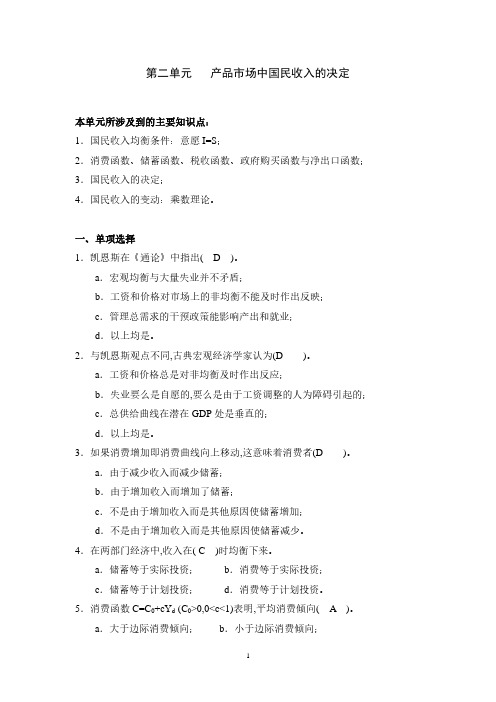
b.税收减去政府转移支付减去政府支出;
c.税收加上政府转移支付加上政府支出;
d.政府预算赤字。
10.收入达到均衡水平时( D )。
a.非意愿存货量为零; b.计划支出等于实际支出;
c.GDP 不会发生改变; d.以上都对。
11.下列哪项经济政策会导致收入水平有最大增长( C ห้องสมุดไป่ตู้。
a.税收减少 50 亿元; b.政府购买增加 50 亿元,同时增加税收 50 亿元;
a.两者完全等同;
b.除了特殊的失衡状态,GDP 均衡水平就是潜在的 GDP 水平;
c.GDP 的均衡水平完全不可能是潜在的 GDP 水平;
d.GDP 的均衡水平可能是也可能不是潜在的 GDP 水平。
21.在产品市场收入决定模型中,消费曲线与 45 度线交点的产出水平表示(D )。
a.净投资支出大于零时的 GDP 水平; b.均衡的 GDP 水平;
d.储蓄小于计划投资。
26.如果由于投资支出下降而导致 GDP 下降,其他条件既定,可预期( )。
a.消费 C 和储蓄 S 将上升;
b.消费 C 和储蓄 S 将下降;
c.消费 C 将下降,但储蓄 S 将上升; d.消费 C 将上升但储蓄 S 将下降。
27.如果其他情况不变,且税收与收入无关,税收增加会使( )。
1
c.等于边际消费倾向; d.以上三种情况都可能。
6.储蓄函数 S=S0+sYd(S0<0,0<s<1)表明,平均储蓄倾向随着可支配收入的增加
( B )。
a.递减; b.递增; c.不变; d.先递减然后递增。
7.凯恩斯之前的古典理论认为( D )。
a.储蓄是收入的函数,而投资是利率的函数;
宏观经济学第2章习题与答案
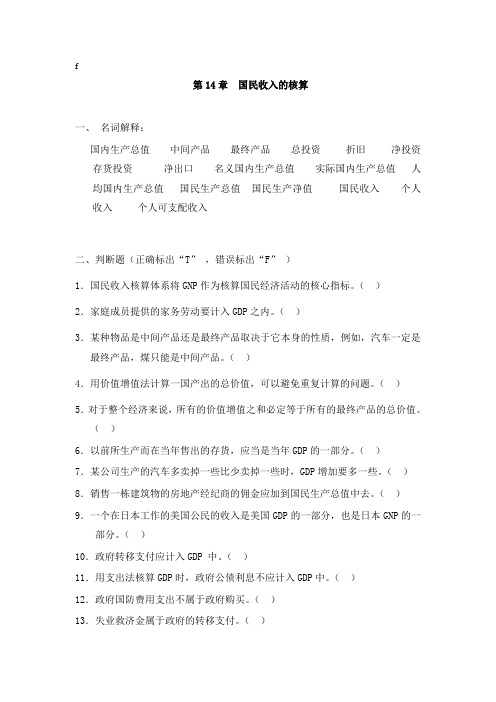
f第14章国民收入的核算一、名词解释:国内生产总值中间产品最终产品总投资折旧净投资存货投资净出口名义国内生产总值实际国内生产总值人均国内生产总值国民生产总值国民生产净值国民收入个人收入个人可支配收入二、判断题(正确标出“T”,错误标出“F”)1.国民收入核算体系将GNP作为核算国民经济活动的核心指标。
()2.家庭成员提供的家务劳动要计入GDP之内。
()3.某种物品是中间产品还是最终产品取决于它本身的性质,例如,汽车一定是最终产品,煤只能是中间产品。
()4.用价值增值法计算一国产出的总价值,可以避免重复计算的问题。
()5.对于整个经济来说,所有的价值增值之和必定等于所有的最终产品的总价值。
()6.以前所生产而在当年售出的存货,应当是当年GDP的一部分。
()7.某公司生产的汽车多卖掉一些比少卖掉一些时,GDP增加要多一些。
()8.销售一栋建筑物的房地产经纪商的佣金应加到国民生产总值中去。
()9.一个在日本工作的美国公民的收入是美国GDP的一部分,也是日本GNP的一部分。
()10.政府转移支付应计入GDP 中。
()11.用支出法核算GDP时,政府公债利息不应计入GDP中。
()12.政府国防费用支出不属于政府购买。
()13.失业救济金属于政府的转移支付。
()14.居民购买住房是一种消费支出,住宅是一种耐用消费品。
()15.购买普通股票是投资的一部分。
()16.总投资增加时,资本存量就增加。
()17.总投资和净投资之差就是GNP和NNP之差。
()18.如果一个企业用购买的一台新设备替换一台报废的旧设备,因为机器数量未变,所以企业购买这台新设备不属于投资行为。
()19.用收入法核算国内生产总值时,资本折旧应计入GDP中。
()20.家庭从公司债券得到的利息应计入GDP中。
()21.国内生产总值是从国民生产总值中减去国外净要素支付后的余额。
()22.折旧费用是国民生产总值的一部分。
()23.国民生产净值衡量的是在一年内对在商品生产中消耗的资本作了调整后的最终产品的市场价值。
宏观经济学习题库(附参考答案)

习题库第一章导论一、名词解释宏观经济学、总量分析、非均衡分析、凯恩斯革命二、简答题1、宏观经济学有什么特点?2、宏观经济学主要研究哪些问题?3、现代宏观经济学是如何产生与演变的?第二章国民收入核算一、名词解释GDP、GNP、NDP、NI、PI、PDI、名义GDP、实际GDP、GDP紧缩指数二、选择题1、下列那些项目应计入GDP?( )。
A. 政府转移支付B. 购买一辆用过的卡车C. 购买普通股票D. 购买一块地产2、已知某一经济中的消费额为6亿元,投资额为1亿元,间接税为1亿元,政府用于物品和劳务的支出额为1.5亿元,出口额为2亿元,进口额为1.8亿元,则()。
A. NDP=8.7亿元B. GDP=7.7亿元C. GDP=8.7亿元D. NDP=5亿元3、所谓净出口是指()。
A. 出口减进口B. 进口减出口C. 出口加进口D. GNP减出口4、在三部门经济中,如果用支出法来衡量,GDP等于()。
A. 消费+投资B. 消费+投资+政府支出C. 消费+投资+政府支出+净出口D. 消费+投资+进出口5、GDP与NDP之间的差别是()。
A. 直接税B. 折旧C. 间接税D. 净出口6、按最终使用者类型,将最终产品和劳务的市场价值加总起来核算GDP的方法是()。
A. 支出法B. 收入法C. 生产法D. 增加价值法7、在统计中,社会保险税增加对()有影响?A. GDPB. NDPC. NID. PI三、简答题1、指出下列各项中,哪些是中间产品,哪些是最终产品?①小王购买一本杂志②某电脑公司购买一批英特尔公司生产的芯片③某政府机构购买一批红旗轿车④旅游时付给入住酒店的房租⑤律师支付租用办公室的房租⑥家庭支付的水电费⑦美国公司向中国购买的农产品2、GDP的统计口径是否忽视了对中间产品生产的核算?3、在证券市场购买股票和债券属于经济学意义上的投资活动吗?4、为什么政府转移支付不能计入GDP?5、为什么间接税应该计入GDP?6、GDP指标有哪些缺陷或不足?7、为什么要区分名义国内生产总值和实际国内生产总值?8、国内生产总值与国民生产总值关系如何?四、计算题1、若某国GDP为8800单位,总投资为1150单位,净投资为292单位,消费为5800单位,政府购买的产品和劳务价值为1500单位,间接税为620单位,政府财政盈余为44单位,求该国NDP、净出口、个人可支配收入、个人储蓄各为多少。
宏观经济学答案 第二章
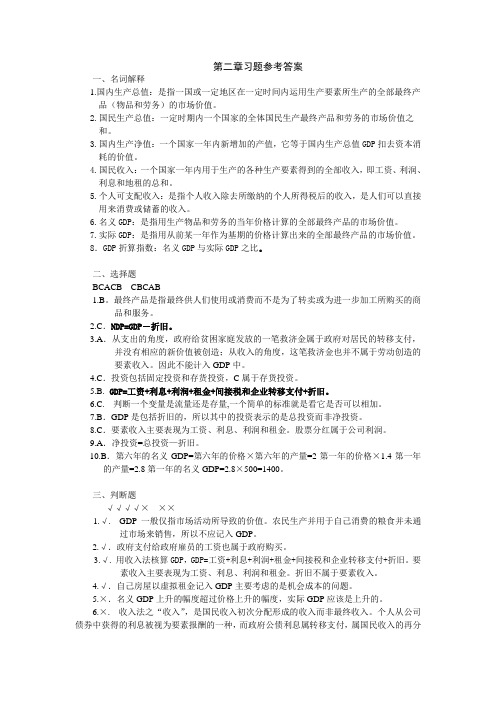
第二章习题参考答案一、名词解释1.国内生产总值:是指一国或一定地区在一定时间内运用生产要素所生产的全部最终产品(物品和劳务)的市场价值。
2.国民生产总值:一定时期内一个国家的全体国民生产最终产品和劳务的市场价值之和。
3.国内生产净值:一个国家一年内新增加的产值,它等于国内生产总值GDP扣去资本消耗的价值。
4.国民收入:一个国家一年内用于生产的各种生产要素得到的全部收入,即工资、利润、利息和地租的总和。
5.个人可支配收入:是指个人收入除去所缴纳的个人所得税后的收入,是人们可以直接用来消费或储蓄的收入。
6.名义GDP:是指用生产物品和劳务的当年价格计算的全部最终产品的市场价值。
7.实际GDP:是指用从前某一年作为基期的价格计算出来的全部最终产品的市场价值。
8.GDP折算指数:名义GDP与实际GDP之比。
二、选择题BCACB CBCAB1.B。
最终产品是指最终供人们使用或消费而不是为了转卖或为进一步加工所购买的商品和服务。
2.C.NDP=GDP-折旧。
3.A.从支出的角度,政府给贫困家庭发放的一笔救济金属于政府对居民的转移支付,并没有相应的新价值被创造;从收入的角度,这笔救济金也并不属于劳动创造的要素收入。
因此不能计入GDP中。
4.C.投资包括固定投资和存货投资,C属于存货投资。
5.B.GDP=工资+利息+利润+租金+间接税和企业转移支付+折旧。
6.C. 判断一个变量是流量还是存量,一个简单的标准就是看它是否可以相加。
7.B.GDP是包括折旧的,所以其中的投资表示的是总投资而非净投资。
8.C.要素收入主要表现为工资、利息、利润和租金。
股票分红属于公司利润。
9.A.净投资=总投资—折旧。
10.B.第六年的名义GDP=第六年的价格×第六年的产量=2第一年的价格×1.4第一年的产量=2.8第一年的名义GDP=2.8×500=1400。
三、判断题√√√√×××1.√. GDP一般仅指市场活动所导致的价值。
《宏观经济学》习题与解答2
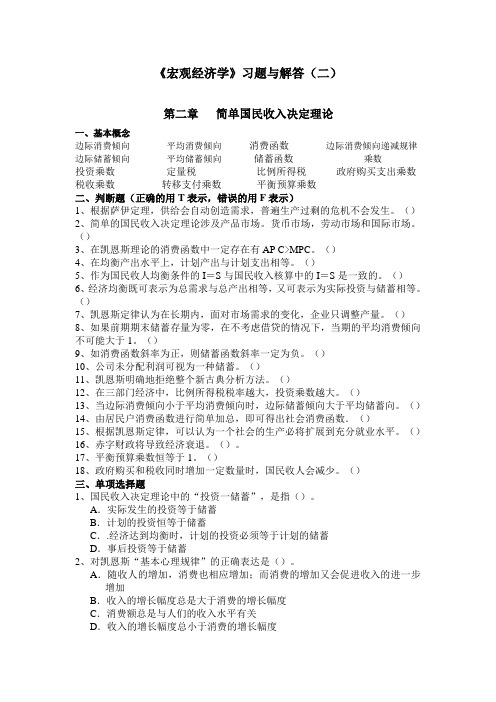
《宏观经济学》习题与解答(二)第二章简单国民收入决定理论一、基本概念边际消费倾向平均消费倾向消费函数边际消费倾向递减规律边际储蓄倾向平均储蓄倾向储蓄函数乘数投资乘数定量税比例所得税政府购买支出乘数税收乘数转移支付乘数平衡预算乘数二、判断题(正确的用T表示,错误的用F表示)1、根据萨伊定理,供给会自动创造需求,普遍生产过剩的危机不会发生。
()2、简单的国民收入决定理论涉及产品市场。
货币市场,劳动市场和国际市场。
()3、在凯恩斯理论的消费函数中一定存在有AP C>MPC。
()4、在均衡产出水平上,计划产出与计划支出相等。
()5、作为国民收人均衡条件的I=S与国民收入核算中的I=S是一致的。
()6、经济均衡既可表示为总需求与总产出相等,又可表示为实际投资与储蓄相等。
()7、凯恩斯定律认为在长期内,面对市场需求的变化,企业只调整产量。
()8、如果前期期末储蓄存量为零,在不考虑借贷的情况下,当期的平均消费倾向不可能大于1。
()9、如消费函数斜率为正,则储蓄函数斜率一定为负。
()10、公司未分配利润可视为一种储蓄。
()11、凯恩斯明确地拒绝整个新古典分析方法。
()12、在三部门经济中,比例所得税税率越大,投资乘数越大。
()13、当边际消费倾向小于平均消费倾向时,边际储蓄倾向大于平均储蓄向。
()14、由居民户消费函数进行简单加总,即可得出社会消费函数.()15、根据凯恩斯定律,可以认为一个社会的生产必将扩展到充分就业水平。
()16、赤字财政将导致经济衰退。
()。
17、平衡预算乘数恒等于1。
()18、政府购买和税收同时增加一定数量时,国民收人会减少。
()三、单项选择题1、国民收入决定理论中的“投资一储蓄”,是指()。
A.实际发生的投资等于储蓄B.计划的投资恒等于储蓄C..经济达到均衡时,计划的投资必须等于计划的储蓄D.事后投资等于储蓄2、对凯恩斯“基本心理规律”的正确表达是()。
A.随收人的增加,消费也相应增加;而消费的增加又会促进收入的进一步增加B.收入的增长幅度总是大于消费的增长幅度C.消费额总是与人们的收入水平有关D.收入的增长幅度总小于消费的增长幅度3、如消费函数为一条向右上方倾斜的直线,则边际消费倾向(),平均消费倾向()A.递减;递减B.递减;不变C.不变;不变D.不变;递减4、已知国民收入为20亿美元,政府预算有2亿美元的赤字,国际收支逆差为2亿美元,储蓄额为4亿美元,则()。
宏观经济学第二章习题
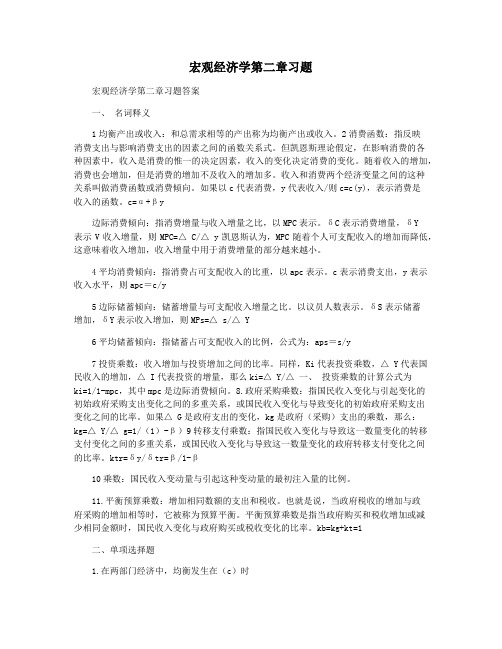
宏观经济学第二章习题宏观经济学第二章习题答案一、名词释义1均衡产出或收入:和总需求相等的产出称为均衡产出或收入。
2消费函数:指反映消费支出与影响消费支出的因素之间的函数关系式。
但凯恩斯理论假定,在影响消费的各种因素中,收入是消费的惟一的决定因素,收入的变化决定消费的变化。
随着收入的增加,消费也会增加,但是消费的增加不及收入的增加多。
收入和消费两个经济变量之间的这种关系叫做消费函数或消费倾向。
如果以c代表消费,y代表收入/则c=c(y),表示消费是收入的函数。
c=α+βy边际消费倾向:指消费增量与收入增量之比,以MPC表示。
δC表示消费增量,δY表示V收入增量,则MPC=△ C/△ y凯恩斯认为,MPC随着个人可支配收入的增加而降低,这意味着收入增加,收入增量中用于消费增量的部分越来越小。
4平均消费倾向:指消费占可支配收入的比重,以apc表示。
c表示消费支出,y表示收入水平,则apc=c/y5边际储蓄倾向:储蓄增量与可支配收入增量之比。
以议员人数表示。
δS表示储蓄增加,δY表示收入增加,则MPs=△ s/△ Y6平均储蓄倾向:指储蓄占可支配收入的比例,公式为:aps=s/y7投资乘数:收入增加与投资增加之间的比率。
同样,Ki代表投资乘数,△ Y代表国民收入的增加,△ I代表投资的增量,那么ki=△ Y/△ 一、投资乘数的计算公式为ki=1/1-mpc,其中mpc是边际消费倾向。
8.政府采购乘数:指国民收入变化与引起变化的初始政府采购支出变化之间的多重关系,或国民收入变化与导致变化的初始政府采购支出变化之间的比率。
如果△ G是政府支出的变化,kg是政府(采购)支出的乘数,那么:kg=△ Y/△ g=1/(1)-β)9转移支付乘数:指国民收入变化与导致这一数量变化的转移支付变化之间的多重关系,或国民收入变化与导致这一数量变化的政府转移支付变化之间的比率。
ktr=δy/δtr=β/1-β10乘数:国民收入变动量与引起这种变动量的最初注入量的比例。
《宏观经济学》章节习题及答案解析
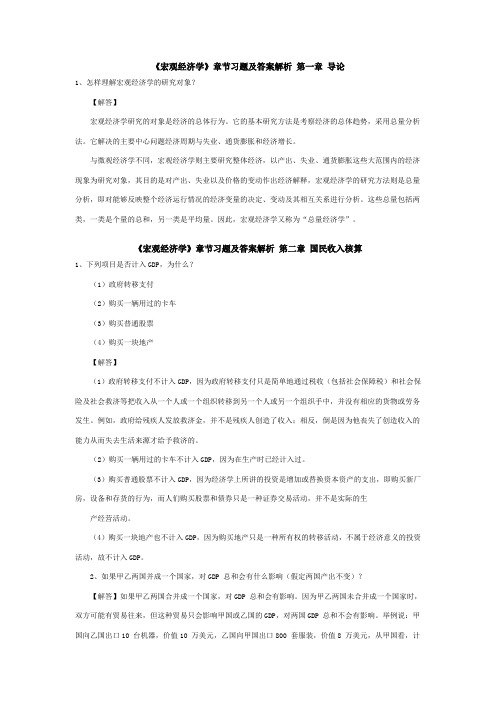
《宏观经济学》章节习题及答案解析第一章导论1、怎样理解宏观经济学的研究对象?【解答】宏观经济学研究的对象是经济的总体行为。
它的基本研究方法是考察经济的总体趋势,采用总量分析法。
它解决的主要中心问题经济周期与失业、通货膨胀和经济增长。
与微观经济学不同,宏观经济学则主要研究整体经济,以产出、失业、通货膨胀这些大范围内的经济现象为研究对象,其目的是对产出、失业以及价格的变动作出经济解释,宏观经济学的研究方法则是总量分析,即对能够反映整个经济运行情况的经济变量的决定、变动及其相互关系进行分析。
这些总量包括两类,一类是个量的总和,另一类是平均量。
因此,宏观经济学又称为“总量经济学”。
《宏观经济学》章节习题及答案解析第二章国民收入核算1、下列项目是否计入GDP,为什么?(1)政府转移支付(2)购买一辆用过的卡车(3)购买普通股票(4)购买一块地产【解答】(1)政府转移支付不计入GDP,因为政府转移支付只是简单地通过税收(包括社会保障税)和社会保险及社会救济等把收入从一个人或一个组织转移到另一个人或另一个组织手中,并没有相应的货物或劳务发生。
例如,政府给残疾人发放救济金,并不是残疾人创造了收入;相反,倒是因为他丧失了创造收入的能力从而失去生活来源才给予救济的。
(2)购买一辆用过的卡车不计入GDP,因为在生产时已经计入过。
(3)购买普通股票不计入GDP,因为经济学上所讲的投资是增加或替换资本资产的支出,即购买新厂房,设备和存货的行为,而人们购买股票和债券只是一种证券交易活动,并不是实际的生产经营活动。
(4)购买一块地产也不计入GDP,因为购买地产只是一种所有权的转移活动,不属于经济意义的投资活动,故不计入GDP。
2、如果甲乙两国并成一个国家,对GDP 总和会有什么影响(假定两国产出不变)?【解答】如果甲乙两国合并成一个国家,对GDP 总和会有影响。
因为甲乙两国未合并成一个国家时,双方可能有贸易往来,但这种贸易只会影响甲国或乙国的GDP,对两国GDP 总和不会有影响。
宏观经济学第二章习题及答案知识讲解

宏观经济学第二章习题及答案第二单元产品市场中国民收入的决定本单元所涉及到的主要知识点:1.国民收入均衡条件:意愿I=S;2.消费函数、储蓄函数、税收函数、政府购买函数与净出口函数;3.国民收入的决定;4.国民收入的变动:乘数理论。
一、单项选择1.凯恩斯在《通论》中指出( D )。
a.宏观均衡与大量失业并不矛盾;b.工资和价格对市场上的非均衡不能及时作出反映;c.管理总需求的干预政策能影响产出和就业;d.以上均是。
2.与凯恩斯观点不同,古典宏观经济学家认为(D )。
a.工资和价格总是对非均衡及时作出反应;b.失业要么是自愿的,要么是由于工资调整的人为障碍引起的;c.总供给曲线在潜在GDP处是垂直的;d.以上均是。
3.如果消费增加即消费曲线向上移动,这意味着消费者(D )。
a.由于减少收入而减少储蓄;b.由于增加收入而增加了储蓄;c.不是由于增加收入而是其他原因使储蓄增加;d.不是由于增加收入而是其他原因使储蓄减少。
4.在两部门经济中,收入在( C )时均衡下来。
a.储蓄等于实际投资; b.消费等于实际投资;c.储蓄等于计划投资; d.消费等于计划投资。
5.消费函数C=C0+cY d (C0>0,0<c<1)表明,平均消费倾向( A )。
a.大于边际消费倾向; b.小于边际消费倾向;c.等于边际消费倾向; d.以上三种情况都可能。
6.储蓄函数S=S0+sY d(S0<0,0<s<1)表明,平均储蓄倾向随着可支配收入的增加( B )。
a.递减; b.递增; c.不变; d.先递减然后递增。
7.凯恩斯之前的古典理论认为( D )。
a.储蓄是收入的函数,而投资是利率的函数;b.储蓄和投资都是收入的函数;c.投资取决于收入,而储蓄取决于利率;d.储蓄和投资都是利率的函数。
8.总产出固定并且国民储蓄与利息率无关时,税收的增加将( D )a.使垂真的储蓄曲线向左移动; b.减少投资;c.增加消费; d.减少均衡利率并增加投资。
宏观经济学习题解答01

《宏观经济学》计算题解答王青2012年3月第二章宏观经济总量及衡量5.已知某国有如下统计资料(单位:亿元)资本消耗补偿356.4,雇员酬金1 866.6,企业利息支付264.9,间接税266.3,个人租金收入34.1,公司利润164.8,非公司业主收入120.8,红利66.4,社会保险税253.9,个人所得税402.1,消费者支付的利息64.4,政府支付的利息105.1,政府和企业的转移支付374.5,个人消费支出1 991.9分别计算国民收入、国内生产净值、国内生产总值、个人收入、个人可支配收入和个人储蓄。
(1)储蓄;(2)投资;(3)解:把文字定义式写上再带入数据计算1、国民收入(NI)=雇员报酬+企业支付的利息+个人租金收入+公司利润+非公司企业主收入=1866.6+264.9+34.1+164.8+120.8=2451.22、国内生产净值(NDP)=国民收入(NI)+间接税=2451.2+266.3=2717.53、国内生产总值(GDP)=(NDP)国内生产净值+资本消耗补偿(折旧)=2717.5+356.4=3073.94、个人收入(PI)=(NI)国民收入-(公司利润+社会保险税)+政府支付的利息+政府的转移支付+红利=2451.2-(164.8+253.9)+374.5+105.1+66.4=2578.55、个人可支配收入(PDI)=个人收入(PI)-个人所得税=2578.5-402.1=2176.46、个人储蓄=(个人可支配收入PDI)-消费者支付的利息-个人消费支出=2176.4-1991.9-64.4=120.16.假定国内生产总值是5 000,个人可支配收入是4 100,政府预算赤字是200,消费是3 800,贸易赤字是100(单位:亿美元)。
试计算:解:GDP=5000 PDI=4100 C=3800 X-M=-100 G-T N=2001、S=PDI-C=4100-3800=3002、四部门中 C+I+G+X=C+S+T N+MS=I+(G-T N)+(X-M) S=I+200-100将 S=300代入 I=S-200+100=300-200+100=2003、GDP=C+I+G+(X-M)G=GDP-C-I-(X-M)=5000-3800-200-(-100)=11007.设一经济社会生产五种产品,它们在1990年和1992年的产量和价格分别产品 1990年的产量 19901992年产量 1992(美元) (美元)A 25 1.50 30 1.60B 50 7.50 60 8.00C 40 6.00 50 7.00D 30 5.00 35 5.50E 60 2.00 70 2.50(1)1990年和1992(2)如果以1990年以基年,则1992(3)计算1990~1992解:1、1990年名义GDP=25×1.5+50×7.5+40×6.0+30×5.0+60×2.0=922.5 1992年名义GDP=30×1.6+60×8.0+50×7.0+35×5.5+70×2.5=1245.52、1992年实际GDP=30×1.5+60×7.5+50×6.0+35×5.0+70×2.0=11103、1990—1992GDP缩减指数=1992年名义GDP/1992年实际GDP×100=1245.5/1110.0×100=112.22第三章简单凯恩斯模型第8题:已知投资增加80亿元,边际储蓄倾向为0.2,试求乘数、收入和消费的变化量及其方向。
《宏观经济学》课后练习题2
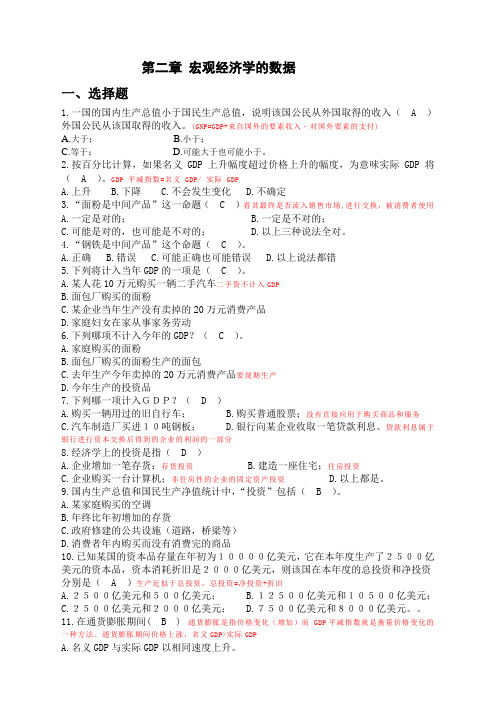
第二章宏观经济学的数据一、选择题1.一国的国内生产总值小于国民生产总值,说明该国公民从外国取得的收入( A )外国公民从该国取得的收入。
(GNP=GDP+来自国外的要素收入–对国外要素的支付)A.大于;B.小于;C.等于;D.可能大于也可能小于。
2.按百分比计算,如果名义GDP上升幅度超过价格上升的幅度,为意味实际GDP将( A )。
GDP 平减指数=名义 GDP/ 实际 GDPA.上升B.下降C.不会发生变化D.不确定3.“面粉是中间产品”这一命题( C )看其最终是否流入销售市场,进行交换,被消费者使用A.一定是对的;B.一定是不对的;C.可能是对的,也可能是不对的;D.以上三种说法全对。
4.“钢铁是中间产品”这个命题( C )。
A.正确B.错误C.可能正确也可能错误D.以上说法都错5.下列将计入当年GDP的一项是( C )。
A.某人花10万元购买一辆二手汽车二手货不计入GDPB.面包厂购买的面粉C.某企业当年生产没有卖掉的20万元消费产品D.家庭妇女在家从事家务劳动6.下列哪项不计入今年的GDP?( C )。
A.家庭购买的面粉B.面包厂购买的面粉生产的面包C.去年生产今年卖掉的20万元消费产品要现期生产D.今年生产的投资品7.下列哪一项计入GDP?( D )A.购买一辆用过的旧自行车;B.购买普通股票;没有直接应用于购买商品和服务C.汽车制造厂买进10吨钢板;D.银行向某企业收取一笔贷款利息。
贷款利息属于银行进行资本交换后得到的企业的利润的一部分8.经济学上的投资是指( D )A.企业增加一笔存货;存货投资B.建造一座住宅;住房投资C.企业购买一台计算机;非住房性的企业的固定资产投资D.以上都是。
9.国内生产总值和国民生产净值统计中,“投资”包括( B )。
A.某家庭购买的空调B.年终比年初增加的存货C.政府修建的公共设施(道路,桥梁等)D.消费者年内购买而没有消费完的商品10.已知某国的资本品存量在年初为10000亿美元,它在本年度生产了2500亿美元的资本品,资本消耗折旧是2000亿美元,则该国在本年度的总投资和净投资分别是( A )生产近似于总投资,总投资=净投资+折旧A.2500亿美元和500亿美元;B.12500亿美元和10500亿美元;C.2500亿美元和2000亿美元;D.7500亿美元和8000亿美元。
曼昆宏观经济学答案第二章

Answers to Textbook Questions and ProblemsCHAPTER 2 The Data of MacroeconomicsQuestions for Review1. GDP measures the total income earned from the production of the new final goods and services in theeconomy, and it measures the total expenditures on the new final goods and services produced in the economy. GDP can measure two things at once because the total expenditures on the new final goods and services by the buyers must be equal to the income earned by the sellers of the new final goods and services. As the circular flow diagram in the text illustrates, these are alternative, equivalent ways of measuring the flow of dollars in the economy.2. The four components of GDP are consumption, investment, government purchases, and net exports.The consumption category of GDP consists of household expenditures on new final goods and services, such as the purchase of a new television. The investment category of GDP consists of business fixed investment, residential fixed investment, and inventory investment. When a business buys newequipment this counts as investment. Government purchases consists of purchases of new final goods and services by federal, state, and local governments, such as payments for new military equipment.Net exports measures the value of goods and services sold to other countries minus the value of goods and services foreigners sell us. When the U.S. sells corn to foreign countries, it counts in the net export category of GDP.3. The consumer price index (CPI) measures the overall level of prices in the economy. It tells us theprice of a fixed basket of goods relative to the price of the same basket in the base year. The GDPdeflator is the ratio of nominal GDP to real GDP in a given year. The GDP deflator measures the prices of all goods and services produced, whereas the CPI only measures prices of goods and servicesbought by consumers. The GDP deflator includes only domestically produced goods, whereas the CPI includes domestic and foreign goods bought by consumers. Finally, the CPI is a Laspeyres index that assigns fixed weights to the prices of different goods, whereas the GDP deflator is a Paasche index that assigns changing weights to the prices of different goods. In practice, the two price indices tend to move together and do not often diverge.4. The CPI measures the price of a fixed basket of goods relative to the price of the same basket in the baseyear. The PCE deflator is the ratio of nominal consumer spending to real consumer spending. The CPI and the PCE deflator are similar in that they both only include the prices of goods purchased byconsumers, and they both include the price of imported goods as well as domestically produced goods.The two measures differ because the CPI measures the change in the price of a fixed basket whereas the goods measured by the PCE deflator change from year to year depending on what consumers are purchasing in that particular year.5. The Bureau of Labor Statistics (BLS) classifies each person into one of the following three categories:employed, unemployed, or not in the labor force. The unemployment rate, which is the percentage of the labor force that is unemployed, is computed as follows:Unemployment Rate = Number of UnemployedLabor Force´100.Note that the labor force is the number of people employed plus the number of people unemployed. 6. Every month, the Bureau of Labor Statistics undertakes two surveys to measure employment. First, theBLS surveys about 60,000 households and thereby obtains an estimate of the share of people who say they are working. The BLS multiplies this share by an estimate of the population to estimate thenumber of people working. Second, the BLS surveys about 160,000 business establishments and asks how many people they employ. Each survey is imperfect; so the two measures of employment are not identical.Problems and Applications1. From the main Web page click on the interactive data tab at the top, select GDP, begin usingthe data, section 1, and then table 1.1.1. Real GDP grew at a rate of 2.2 percent in quarter 4 of 2014.When compared to growth rates of −2.1percent, 4.6 percent, and 5 percent for the first three quarters of 2014, the rate of 2.2 percent was slightly below average. From the main Web page select the data tools tab, then top picks. Check the box for the unemployment rate and retrieve the data. The unemployment rate in March 2015 was 5.5 percent, which was about equal to the natural rate ofunemployment, or the long run average rate. From the main page, select the economic releases tab, then inflation and prices. Access the report for the CPI. In February 2015, the inflation rate for all items was 0 percent, and if food and energy were excluded the rate was 1.7 percent. The inflation rate was below average and below the Federal Reserve’s target of 2 percent.2. Value added by each person is equal to the value of the good produced minus the amount the personpaid for the materials needed to make the good. Therefore, the value added by the farmer is $1.00 ($1 –0 = $1). The value added by the miller is $2: she sells the flour to the baker for $3 but paid $1 for theflour. The value added by the baker is $3: she sells the bread to the engineer for $6 but paid the miller $3 for the flour. GDP is the total value added, or $1 + $2 + $3 = $6. Note that GDP equals the value of the final good (the bread).3. When a woman marries her butler, GDP falls by the amount of the butler’s salary. This happensbecause GDP measures total income, and therefore GDP, falls by t he amount of the butler’s loss i n salary. If GDP truly measures the value of all goods and services, then the marriage would not affect GDP since the total amount of economic activity is unchanged. Actual GDP, however, is an imperfect measure of economic activity because the value of some goods and services is left out. Once thebutler’s work becomes part of his household chores, his services are no longer counted in GDP. As this example illustrates, GDP does not include the value of any output produced in the home.4. a. The airplane sold to the U.S. Air Force counts as government purchases because the Air Force ispart of the government.b. The airplane sold to American Airlines counts as investment because it is a capital good sold to aprivate firm.c. The airplane sold to Air France counts as an export because it is sold to a foreigner.d. The airplane sold to Amelia Earhart counts as consumption because it is sold to a privateindividual.e. The airplane built to be sold next year counts as investment. In particular, the airplane is countedas inventory investment, which is where goods that are produced in one year and sold in anotheryear are counted.5. Data on parts (a) to (f) can be downloaded from the Bureau of Economic Analysis. Go to the Website, click on the interactive data tab at the top, select GDP, begin using the data, section 1, and then table 1.1.5. Choose the ―modify the data‖ option to select the years you in which you areinterested. By dividing each component (a) to (f) by nominal GDP and multiplying by 100, we obtain the following percentages:1950 1980 2014a. Personal consumption expenditures 64.0% 61.3% 68.5%b. Gross private domestic investment 18.8% 18.5% 16.4%c. Government consumption purchases 16.9% 20.6% 18.2%d. Net exports 0.2% –0.5% 3.1%e. National defense purchases 7.6% 6.3% 4.4%f. Imports 3.9% 10.3% 16.5%(Note: The above data was downloaded April 3, 2015, from the BEA Web site.)Among other things, we observe the following trends in the economy over the period 1950–2015:a. Personal consumption expenditures have been around two-thirds of GDP between 1980 and 2015.b. The share of GDP going to gross private domestic investment remained fairly steady.c. The share going to government consumption purchases rose sharply from 1950 to 1980.d. Net exports, which were positive in 1950, have been negative since that time.e. The share going to national defense purchases has fallen.f. Imports have grown rapidly relative to GDP.6.a. GDP measures the value of the final goods and services produced, or $1,000,000.b. NNP is equal to GNP minus depreciation. In this example, GDP is equal to GNP because there areno foreign transactions. Therefore, NNP is equal to $875,000.c. National income is equal to NNP, or $875,000.d. Employee compensation is equal to $600,000.e. Proprietors ’ income measures the income of the owner,and is equal to 150,000.f. Corporate profit is equal to corporate taxes plus dividends plus retained earnings, or $275,000. Retained earnings is calculated as sales minus wages minus dividends minus depreciation minus corporate tax, or $75,000.g. Personal income is equal to employee compensation plus dividends, or $750,000.h. Disposable personal income is personal income minus taxes, or $550,000.7. a. i.Nominal GDP is the total value of goods and services measured at currentprices. Therefore,Nominal GDP 2010 = P hotdogs 2010´Q hotdogs 2010()+P burgers 2010´Q burgers 2010()= ($2⨯200) + ($3⨯200)= $400 + $600= $1,000.Nominal GDP 2015 = P hotdogs 2015´Q hotdogs 2015()+P burgers 2015´Q burgers 2015()= ($4⨯ 250) + ($4⨯500)= $1,000 + $2,000= $3,000.ii. Real GDP is the total value of goods and services measured at constantprices. Therefore, to calculate real GDP in 2015 (with base year 2010), multiplythe quantities purchased in the year 2015 by the 2010 prices:Real GDP 2015 = P 2010hotdogs ´Q 2015hotdogs ()+P 2010burgers ´Q 2015burgers ()= ($2⨯ 250) + ($3⨯500)= $500 + $1,500= $2,000.Real GDP for 2010 is calculated by multiplying the quantities in 2010 by theprices in 2010. Since the base year is 2010, real GDP 2010 equals nominalGDP 2010, which is $10,00. Hence, real GDP increased between2010 and 2015.iii. The implicit price deflator for GDP compares the current prices of all goodsand services produced to the prices of the same goods and services in a baseyear. It is calculated as follows:Implicit Price Deflator 2015 = Nominal GDP 2010Real GDP 2010 = 1Using the values for Nominal GDP 2015 and real GDP 2015 calculated above:Implicit Price Deflator 2015=$3,000$2,000= 1.50.This calculation reveals that prices of the goods produced in the year 2015increased by 50 percent compared to the prices that the goods in the economysold for in 2010. (Because 2010 is the base year, the value for the implicitprice deflator for the year 2010 is 1.0 becausenominal and real GDP are thesame for the base year.)iv. The consumer price index (CPI) measures the level of prices in the economy.The CPI is called a fixed-weight index because it uses a fixed basket of goods over time to weight prices.If the base year is 2010, the CPI in 2015 is measuring the cost of the basket in 2015 relative to the cost in 2010. The CPI2015 is calculated as follows:CPI2015= (P2015hotdogs´Q2010hotdogs) + (P2015burgers´Q2010burgers)(P2010hotdogs´Q2010hotdogs) + (P2010burgers´Q2010burgers)= $16,000,000 $10,000,000= 1.6.This calculation shows that the price of goods purchased in 2015 increased by 60percentcompared to the prices these goods would have sold for in 2010. The CPIfor 2010, the baseyear, equals 1.0.b. The implicit price deflator is a Paasche index because it is computed with a changingbasket ofgoods; the CPI is a Laspeyres index because it is computed with afixed basket of goods. From(7.a.iii), the implicit price deflator for the year 2015 is1.50, which indicates that prices rose by 50percent from what they were in theyear 2010. From (7.a.iv.), the CPI for the year 2015 is 1.6,which indicates thatprices rose by 60 percent from what they were in the year 2010.If prices of all goods rose by, for example, 50 percent, then one could say unambiguouslythat the price level rose by 50 percent. Yet, in our example, relativeprices have changed. The price ofhot dogs rose by 1020 percent; the price of hamburgers roseby 33.33 percent, making hamburgers relatively less expensive.As the discrepancy between the CPI and the implicit price deflator illustrates,the change in the price level depends on how the goods’ prices are weighted.The CPI weights the price of goods by the quantities purchased in the year2010. The implicit price deflator weights the price of goods by the quantities purchasedin the year 2015. Since the quantity of the two goods was the same in2010, the CPI is placing equal weight on the two price changes. In 2015, the quantity ofhamburgers was twice as large as hot dogs, so there is twice as much weight placed on thehamburger price relative to the hot dog price. For this reason, the CPI shows a larger inflation rate – more weight is placed on the good with the larger price increase.8. a. The consumer price index uses the consumption bundle in year 1 to figure out howmuch weight toput on the price of a given good:CPI2=$2´10()+$1´0() $1´10()+$2´0()=P2red´Q1red()+P2green´Q1green()P1red´Q1red()+P1green´Q1green()= 2.According to the CPI, prices have doubled.b. Nominal spending is the total value of output produced in each year. In year 1 and year 2, Abbybuys 10 apples for $1 each, so her nominal spending remains constant at $10. For example,Nominal Spending2= P2red ´Q2red()+P2green´Q2green()= ($2 ⨯ 0) + ($1 ⨯ 10)= $10.c. Real spending is the total value of output produced in each year valued at the prices prevailing inyear 1. In year 1, the base year, her real spending equals her nominal spending of $10. In year 2, she consumes 10 green apples that are each valued at their year 1 price of $2, so her real spending is $20. That is,Real Spending2= P1red ´Q2red()+P1green´Q2green()= ($1 ⨯ 0) + ($2 ⨯ 10)= $20.Hence, Abby’s real spending rises from $10 to $20.d. The implicit price deflator is calculated by dividing Abby’s nominal spending inyear 2 by her realspending that year:Implicit Price Deflator2=Nominal Spending2 Real Spending2=$10 $20= 0.5.Thus, the implicit price deflator suggests that prices have fallen by half. The reasonfor this is that the deflator estimates how much Abby values her apples usingprices prevailing in year 1. Fromthis perspective green apples appear very valuable.In year 2, when Abby consumes 10 greenapples, it appears that her consumptionhas increased because the deflator values green apples more highly thanred apples. The only way she could still be spending $10 on a higherconsumptionbundle is if the price of the good she was consuming fell.e. If Abby thinks of red apples and green apples as perfect substitutes, then the costof living in thiseconomy has not changed—in either year it costs $10 to consume10 apples. According to the CPI, however, the cost of living has doubled. This isbecause the CPI only takes into account the factthat the red apple price has doubled;the CPI ignores the fall in the price of green apples becausethey were not inthe consumption bundle in year 1. In contrast to the CPI, the implicit pricedeflatorestimates the cost of living has been cut in half. Thus, the CPI, a Laspeyresindex,overstates the increase in the cost of living and the deflator, a Paascheindex, understates it.9. a. The labor force includes full time workers, part time workers, those who run their own business,and those who do not have a job but are looking for a job. The labor force consists of 70 people.The working age population consists of the labor force plus those not in the labor force. The 10discouraged workers and the 10 retired people are not in the labor force, but assuming they arecapable of working, they are part of the adult population. The adult population consists of 90people, so the labor force participation rate is equal to 70/90 or 77.8 percent.b. The number of unemployed workers is equal to 10, so the unemployment rate is 10/70 or 14.3percent.c. The household survey estimates total employment by asking a sample of households about theiremployment status. The household survey would report 60 people employed. The establishmentsurvey estimates total employment by asking a sample of businesses to report how many workers they are employing. In this case the establishment survey would report 55 people employed. The 5 people with 2 jobs would be counted twice, and the 10 people who run their own business wouldnot be counted.10. As Senator Robert Kennedy pointed out, GDP is an imperfect measure of economic performance orwell-being. In addition to the left-out items that Kennedy cited, GDP alsoignores the imputed rent on durable goods such as cars, refrigerators, and lawnmowers;many services and products produced as part of household activity, such as cooking andcleaning; and the value of goods produced and sold in illegal activities, such as the drugtrade. These imperfections in the measurement of GDP do notnecessarily reduce itsusefulness. As long as these measurement problems stay constant over time, then GDPis useful in comparing economic activity from year to year. Moreover, a large GDPallows us to afford better medical care for our children, newer books for their education,and more toys for their play. Finally, countries with higher levels of GDP tend to havehigher levels of life expectancy, better access to clean water and sanitation, and higherlevels of education. GDP is therefore a useful measure for comparing the level ofgrowth and development across countries.11. a. Real GDP falls because Disney World does not produce any services while it is closed. Thiscorresponds to a decrease in economic well-being because the income of workers and shareholders of Disney World falls (t he income side of the national accounts), and people’s consumption ofDisney World falls (the expenditure side of the national accounts).b. Real GDP rises because the original capital and labor in farm production now produce more wheat.This corresponds to an increase in the economic well-being of society, since people can nowconsume more wheat. (If people do not want to consume more wheat, then farmers and farmlandcan be shifted to producing other goods that society values.)c. Real GDP falls because with fewer workers on the job, firms produce less. This accurately reflectsa fall in economic well-being.d. Real GDP falls because the firms that lay off workers produce less. This decreases economic well-being because workers’ incomes fall (the inco me side), and there are fewer goods for people tobuy (the expenditure side).e. Real GDP is likely to fall, as firms shift toward production methods that produce fewer goods butemit less pollution. Economic well-being, however, may rise. The economy now produces lessmeasured output but more clean air. Clean air is not traded in markets and, thus, does not show up in measured GDP, but is nevertheless a good that people value.f. Real GDP rises because the high school students go from an activity in which they are notproducing market goods and services to one in which they are. Economic well-being, however,may decrease. In ideal national accounts, attending school would show up as investment because it presumably increases the future productivity of the worker. Actual national accounts do notmeasure this type of investment. Note also that future GDP may be lower than it would be if thestudents stayed in school, since the future work force will be less educated.g. Measured real GDP falls because fathers spend less time producing market goods and services.The actual production of goods and services need not have fallen because but unmeasuredproduction of child-rearing services rises. The well-being of the average person may very well rise if we assume the fathers and the children enjoy the extra time they are spending together.。
宏观经济学答案-第二章

宏观经济学答案-第二章和租金。
股票分红属于公司利润。
9.A.净投资=总投资—折旧。
10.B.第六年的名义GDP=第六年的价格×第六年的产量=2第一年的价格×1.4第一年的产量=2.8第一年的名义GDP=2.8×500=1400。
三、判断题√√√√×××1.√. GDP一般仅指市场活动所导致的价值。
农民生产并用于自己消费的粮食并未通过市场来销售,所以不应记入GDP。
2.√.政府支付给政府雇员的工资也属于政府购买。
3.√. 用收入法核算GDP,GDP=工资+利息+利润+租金+间接税和企业转移支付+折旧。
要素收入主要表现为工资、利息、利润和租金。
折旧不属于要素收入。
4.√.自己房屋以虚拟租金记入GDP主要考虑的是机会成本的问题。
5.×.名义GDP上升的幅度超过价格上升的幅度,实际GDP应该是上升的。
6.×. 收入法之“收入”,是国民收入初次分配形成的收入而非最终收入。
个人从公司债券中获得的利息被视为要素报酬的一种,而政府公债利息属转移支付,属国民收入的再分配。
7.×.GNP=GDP+本国居民在国外的收入-外国居民在本国的收入。
四、简答题1. 简述国内生产总值、国内生产净值、国民收入、个人收入、个人可支配收入之间的关系。
答:国内生产总值GDP是指一个国家在一定时期内所生产的最终产品和劳务的市场价值总额,是一个地域的概念;国内生产净值NDP是指国内生产总值扣除折旧后的余额,即NDP=GDP—折旧;而国民收入NI是指一国生产要素所有者在一定时期内从生产中所获得的全部收入,狭义NI=NDP—间接税。
个人收入PI,是指经过收入再分配后的国民收入,PI=NI-公司留存利润-公司所得税+政府对个人的转移支付;而个人可支配收入DPI是指个人收入扣除个人所得税之后的余额,即DPI=PI-个人所得税。
2. 国民核算的两种主要方法。
答:(1)国民收入是进行宏观分析的关键,因为宏观经济学研究的是整个社会的经济活动,以社会整体的经济行为及其经济后果为研究对象。
宏观经济学第二章习题与答案

第二单元产品市场中国民收入的决定本单元所涉及到的主要知识点:1.国民收入均衡条件:意愿I=S;2.消费函数、储蓄函数、税收函数、政府购买函数与净出口函数;3.国民收入的决定;4.国民收入的变动:乘数理论。
一、单项选择1.凯恩斯在《通论》中指出( D )。
a.宏观均衡与大量失业并不矛盾;b.工资和价格对市场上的非均衡不能及时作出反映;c.管理总需求的干预政策能影响产出和就业;d.以上均是。
2.与凯恩斯观点不同,古典宏观经济学家认为(D )。
a.工资和价格总是对非均衡及时作出反应;b.失业要么是自愿的,要么是由于工资调整的人为障碍引起的;c.总供给曲线在潜在GDP处是垂直的;d.以上均是。
3.如果消费增加即消费曲线向上移动,这意味着消费者(D )。
a.由于减少收入而减少储蓄;b.由于增加收入而增加了储蓄;c.不是由于增加收入而是其他原因使储蓄增加;d.不是由于增加收入而是其他原因使储蓄减少。
4.在两部门经济中,收入在( C )时均衡下来。
a.储蓄等于实际投资;b.消费等于实际投资;c.储蓄等于计划投资;d.消费等于计划投资。
5.消费函数C=C0+cY d (C0>0,0<c<1)表明,平均消费倾向( A )。
a.大于边际消费倾向;b.小于边际消费倾向;c.等于边际消费倾向;d.以上三种情况都可能。
6.储蓄函数S=S0+sY d(S0<0,0<s<1)表明,平均储蓄倾向随着可支配收入的增加( B )。
a.递减;b.递增;c.不变;d.先递减然后递增。
7.凯恩斯之前的古典理论认为( D )。
a.储蓄是收入的函数,而投资是利率的函数;b.储蓄和投资都是收入的函数;c.投资取决于收入,而储蓄取决于利率;d.储蓄和投资都是利率的函数。
8.总产出固定并且国民储蓄与利息率无关时,税收的增加将(D )a.使垂真的储蓄曲线向左移动;b.减少投资;c.增加消费;d.减少均衡利率并增加投资。
刘天祥版宏观经济学教材第2版各章参考答案
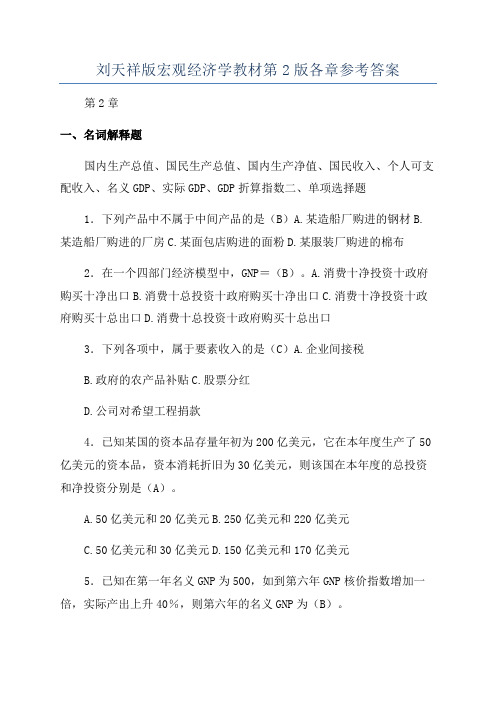
刘天祥版宏观经济学教材第2版各章参考答案第2章一、名词解释题国内生产总值、国民生产总值、国内生产净值、国民收入、个人可支配收入、名义GDP、实际GDP、GDP折算指数二、单项选择题1.下列产品中不属于中间产品的是(B)A.某造船厂购进的钢材B.某造船厂购进的厂房C.某面包店购进的面粉D.某服装厂购进的棉布2.在一个四部门经济模型中,GNP=(B)。
A.消费十净投资十政府购买十净出口B.消费十总投资十政府购买十净出口C.消费十净投资十政府购买十总出口D.消费十总投资十政府购买十总出口3.下列各项中,属于要素收入的是(C)A.企业间接税B.政府的农产品补贴C.股票分红D.公司对希望工程捐款4.已知某国的资本品存量年初为200亿美元,它在本年度生产了50亿美元的资本品,资本消耗折旧为30亿美元,则该国在本年度的总投资和净投资分别是(A)。
A.50亿美元和20亿美元B.250亿美元和220亿美元C.50亿美元和30亿美元D.150亿美元和170亿美元5.已知在第一年名义GNP为500,如到第六年GNP核价指数增加一倍,实际产出上升40%,则第六年的名义GNP为(B)。
A.2000B.1400C.1000D.750三、判断题1.农民生产并用于自己消费的粮食不应计入GNP。
(对)2.在进行国民收入核算时,政府为公务人员加薪,应视为政府购买。
(对)3.用收入法计算的GNP中包括折旧,但折旧不属于要素收入。
(对)4.房主把房屋出租所获得的租金和自己居住所形成的虚拟租金均应计入GNP。
(对)5.按百分比计算,如果名义GDP上升超过价格上升的幅度,则实际GDP下降。
(错)四、简答题(略)五、计算题1.假设GNP为5000,DPI为4100,政府预算赤字为200,消费为300,外贸赤字为100(单位10亿美元)。
试求:投资1,政府购买G。
解:1.由Y=C+I+G+N某(1)DPI=Y-T(2)且G-T=200(3)Y=GDP=5000,DPI=4100,G-T=200,I=300,N某=-100综上所得,I=3700,G=1100.2.一经济社会生产三种产品:书本、面粉和食用油。
2020年整理宏观经济学第二章习题及答案.doc
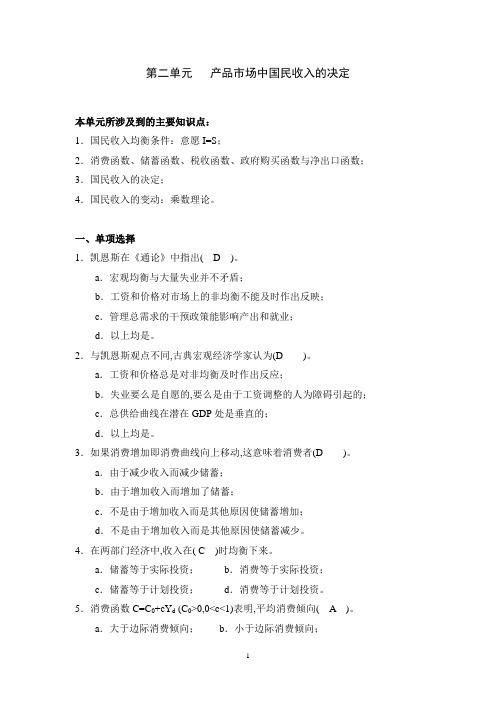
第二单元产品市场中国民收入的决定本单元所涉及到的主要知识点:1.国民收入均衡条件:意愿I=S;2.消费函数、储蓄函数、税收函数、政府购买函数与净出口函数;3.国民收入的决定;4.国民收入的变动:乘数理论。
一、单项选择1.凯恩斯在《通论》中指出( D )。
a.宏观均衡与大量失业并不矛盾;b.工资和价格对市场上的非均衡不能及时作出反映;c.管理总需求的干预政策能影响产出和就业;d.以上均是。
2.与凯恩斯观点不同,古典宏观经济学家认为(D )。
a.工资和价格总是对非均衡及时作出反应;b.失业要么是自愿的,要么是由于工资调整的人为障碍引起的;c.总供给曲线在潜在GDP处是垂直的;d.以上均是。
3.如果消费增加即消费曲线向上移动,这意味着消费者(D )。
a.由于减少收入而减少储蓄;b.由于增加收入而增加了储蓄;c.不是由于增加收入而是其他原因使储蓄增加;d.不是由于增加收入而是其他原因使储蓄减少。
4.在两部门经济中,收入在( C )时均衡下来。
a.储蓄等于实际投资;b.消费等于实际投资;c.储蓄等于计划投资;d.消费等于计划投资。
5.消费函数C=C0+cY d (C0>0,0<c<1)表明,平均消费倾向( A )。
a.大于边际消费倾向;b.小于边际消费倾向;c.等于边际消费倾向;d.以上三种情况都可能。
6.储蓄函数S=S0+sY d(S0<0,0<s<1)表明,平均储蓄倾向随着可支配收入的增加( B )。
a.递减;b.递增;c.不变;d.先递减然后递增。
7.凯恩斯之前的古典理论认为( D )。
a.储蓄是收入的函数,而投资是利率的函数;b.储蓄和投资都是收入的函数;c.投资取决于收入,而储蓄取决于利率;d.储蓄和投资都是利率的函数。
8.总产出固定并且国民储蓄与利息率无关时,税收的增加将(D )a.使垂真的储蓄曲线向左移动;b.减少投资;c.增加消费;d.减少均衡利率并增加投资。
- 1、下载文档前请自行甄别文档内容的完整性,平台不提供额外的编辑、内容补充、找答案等附加服务。
- 2、"仅部分预览"的文档,不可在线预览部分如存在完整性等问题,可反馈申请退款(可完整预览的文档不适用该条件!)。
- 3、如文档侵犯您的权益,请联系客服反馈,我们会尽快为您处理(人工客服工作时间:9:00-18:30)。
第二单元产品市场中国民收入的决定本单元所涉及到的主要知识点:1.国民收入均衡条件:意愿I=S;2.消费函数、储蓄函数、税收函数、政府购买函数与净出口函数;3.国民收入的决定;4.国民收入的变动:乘数理论。
一、单项选择1.凯恩斯在《通论》中指出( D )。
a.宏观均衡与大量失业并不矛盾;b.工资和价格对市场上的非均衡不能及时作出反映;c.管理总需求的干预政策能影响产出和就业;d.以上均是。
2.与凯恩斯观点不同,古典宏观经济学家认为(D )。
a.工资和价格总是对非均衡及时作出反应;b.失业要么是自愿的,要么是由于工资调整的人为障碍引起的;c.总供给曲线在潜在GDP处是垂直的;d.以上均是。
3.如果消费增加即消费曲线向上移动,这意味着消费者(D )。
a.由于减少收入而减少储蓄;b.由于增加收入而增加了储蓄;c.不是由于增加收入而是其他原因使储蓄增加;d.不是由于增加收入而是其他原因使储蓄减少。
4.在两部门经济中,收入在( C )时均衡下来。
a.储蓄等于实际投资;b.消费等于实际投资;c.储蓄等于计划投资;d.消费等于计划投资。
5.消费函数C=C0+cY d (C0>0,0<c<1)表明,平均消费倾向( A )。
a.大于边际消费倾向;b.小于边际消费倾向;c.等于边际消费倾向;d.以上三种情况都可能。
6.储蓄函数S=S0+sY d(S0<0,0<s<1)表明,平均储蓄倾向随着可支配收入的增加( B )。
a.递减;b.递增;c.不变;d.先递减然后递增。
7.凯恩斯之前的古典理论认为( D )。
a.储蓄是收入的函数,而投资是利率的函数;b.储蓄和投资都是收入的函数;c.投资取决于收入,而储蓄取决于利率;d.储蓄和投资都是利率的函数。
8.总产出固定并且国民储蓄与利息率无关时,税收的增加将(D )a.使垂真的储蓄曲线向左移动;b.减少投资;c.增加消费;d.减少均衡利率并增加投资。
9.三部门经济中的公共储蓄等于(B )。
a.税收加上政府转移支付减去政府购买;b.税收减去政府转移支付减去政府支出;c.税收加上政府转移支付加上政府支出;d.政府预算赤字。
10.收入达到均衡水平时(D )。
a.非意愿存货量为零;b.计划支出等于实际支出;c.GDP不会发生改变;d.以上都对。
11.下列哪项经济政策会导致收入水平有最大增长(C )。
a.税收减少50亿元;b.政府购买增加50亿元,同时增加税收50亿元;c.政府增加购买50亿元;d.政府转移支付增加50亿元。
12.收入超过支出,公司将减少生产,因为非计划存货量为( A )。
a.正;b.负;c.零;d.不确定。
13.存在资源闲置的条件下,如果政府支出增加,那么GDP将( D )。
a.减少,但其减少量小于政府支出的增加量;b.减少,但其减少量多于政府支出的增加量;c.增加,但其增加量小于政府支出的增加量;d.增加,但其增加量多于政府支出的增加量。
14.假定其他条件不变,税收增加将引起GDP( C )。
a.增加,但消费水平下降;b.增加,同时消费水平提高;c.减少,同时消费水平下降;d.减少,但消费水平提高;15.如果投资支出下降,那么( B )。
a.GDP将下降,但其下降量小于投资的下降量;b.GDP将下降,其下降量大于投资的下降量;c.GDP将增加,其增加量小于投资的下降量;d.GDP将增加,其增加量大于投资的下降量。
16.在短期,实际GDP可能( D )潜在GDP。
a.等于;b.大于;c.小于;d.等于,也可能大于或小于。
17.假定其他条件不变,投资增加将引起( B )。
a.国民收入增加,但消费水平不变;b.国民收入增加,同时消费水平提高;c.国民收入增加,但消费水平下降;d.国民收入增加,储蓄水平下降。
18.如果投资减少,可预期( C )。
a.GDP将下降,但储蓄S将不变;b.GDP将下降,但储蓄S将上升;c.GDP和储蓄S都下降;d.GDP不变,但储蓄S下降。
19.自发消费支出减少,则( C )。
a.GDP将下降,但储蓄S不变;b.GDP将下降,但储蓄S将上升;c.GDP和引至储蓄都将下降;d.GDP不变,但储蓄S下降。
20.均衡水平的GDP与潜在GDP的关系是( D )。
a.两者完全等同;b.除了特殊的失衡状态,GDP均衡水平就是潜在的GDP水平;c.GDP的均衡水平完全不可能是潜在的GDP水平;d.GDP的均衡水平可能是也可能不是潜在的GDP水平。
21.在产品市场收入决定模型中,消费曲线与45度线交点的产出水平表示(D )。
a.净投资支出大于零时的GDP水平;b.均衡的GDP水平;c.消费C和投资相等;d.消费恰好等于收入。
22.在产品市场收入决定模型中,实际GDP高于均衡水平,意味着( )。
a.储蓄大于实际投资;b.储蓄小于实际投资;c.储蓄小于计划投资;d.储蓄大于计划投资。
23.在产品市场收入决定模型中,如果政府同时等量地增加转移支付与税收,则GDP()。
a.将下降;b.不变;c.将增加;d.将增加,但增加量小于政府转移支付的量。
24.下列哪一种情况不会使收入水平增加( )。
a.自发性支出增加;b.自发性税收下降;c.政府转移支付增加;d.净税收增加。
25.GDP低于均衡水平,意味着( )。
a.储蓄大于计划投资;b.消费大于计划投资;c.消费小于计划投资;d.储蓄小于计划投资。
26.如果由于投资支出下降而导致GDP下降,其他条件既定,可预期( )。
a.消费C和储蓄S将上升;b.消费C和储蓄S将下降;c.消费C将下降,但储蓄S将上升;d.消费C将上升但储蓄S将下降。
27.如果其他情况不变,且税收与收入无关,税收增加会使( )。
a.总支出曲线上移c△T;b.总支出曲线下移c△T;c.总支出曲线上移幅度超过c△T;d.总支出曲线下移幅度小于c△T。
28.当国民收入均衡时,必然有( )a.收入=消费+储蓄;b.收入=投资+储蓄;c.收入=消费;d.收入=消费+投资。
29.若其他情况不变,所得税税率的提高会使( )a.支出乘数和税收乘数都变大;b.支出乘数和税收乘数都变小;c.支出乘数增大,税收乘数变小;d.支出乘数变小,税收乘数变大。
30.在凯恩斯的两部门经济模型中,如果边际消费倾向为0.6,那么自发支出乘数为( )。
a.1.6;b.2.5;c.5;d.4。
31.在两部门经济中,若现期收入为5000亿元,其中3800亿元用于消费,计划投资支出1500亿元。
这表明( )。
a.不处于均衡水平,将下降;b.收入不处于均衡水平,将上升;c.收入处于均衡水平;d.以上三种情况都可能。
32.两部门经济中,如果边际消费倾向为0.8,投资支出增加50亿元,可以预期收入将增加( )。
a.50亿元;b.250亿元;c.100亿元;d.200亿元。
33.三部门经济中的平衡预算乘数是指( )a.预算平衡时的乘数;b.政府购买支出和税收同时同方向同幅度变动时,收入的变化量与政府购买支出或税收变化量之比;c.政府转移支付和税收同时同方向同幅度变动时,收入的变化量与政府转移支付或税收变化之比;d.以上三种情况都对。
34.若政府税收为收入的函数,则三部门经济与两部门经济相比,乘数效应( ) a.变小;b.变大;c.不变;d.以上三种情况都可能。
35.引致消费量的大小取决于( )的大小。
a.边际消费倾向;b.边际储蓄倾向;c.平均消费倾向;d.收入和边际消费倾向。
36.已知:国民收入总额等于10亿元,政府预算有1亿元的赤字,国际收支有l亿元的逆差,储蓄额等于2亿元则()。
a.消费额等于7.5亿元;b.政府支出额为1.5亿元;c.消费加政府支出等于8亿元;d.投资等于2亿元。
37.若其他情况不变,所得税税率提高时,投资乘数()。
a.将增大;b.将缩小;c.不变;d.可能增大也可能缩小。
38.在产品市场收入决定模型中,如果净出口增加,则GDP()。
a.将下降,且下降量等于净出口的增加量;b.将下降,且下降量多于净出口的增加量;c.将增加,且增加量等于净出口的增加量;d.将增加,且增加量多于净出口的增加量。
39.根据生命周期理论,完善的社会保障系统会使得边际消费倾向()。
a.增大;b.不变;c.变小;d.不能确定。
40.下列哪种消费理论认为居民消费不会随经济的繁荣与衰退而变化()。
a.凯恩斯消费理论;b.生命周期理论;c.持久收入假说;d.相对收入假说。
二、多项选择题1.投资水平取决于两个基本因素是( )。
a.产品价格;b.预期利润率;c.税率;d.利率。
2.根据投资与收入的关系,可知总投资包括( )。
a.存货投资;b.实际投资;c.自发投资;d.引致投资。
3.均衡国民收入的条件是( )。
a.总需求等于总供给;b.总支出等于总收入;c.漏出等于注入;d.实际投资等于储蓄。
4.漏出是指那些没有用于总支出的剩余收入,如( )。
a.储蓄;b.投资;c.税收;d.进口。
5.注入是指那些不依赖总收入的额外支出,如( )。
a.投资;b.税收;c.政府支出;d.进口。
6.在四部门经济中,对国民收入起收缩作用的有( )。
a.储蓄;b.税收;c.进口;d.政府支出。
7.在四部门经济中,引起国民收入扩张的是( )。
a.税收;b.出口;c.投资;d.政府支出。
8.下列哪几种情况下,投资乘数会越大( )。
a.边际消费倾向越大;b.边际消费倾向越小;c.边际税率越高;d.边际储蓄倾向越小。
9.下列哪些乘数取正值( )。
a.投资乘数;b.税收乘数;c.政府购买乘数;d.对外贸易乘数。
10.( )等于1。
a.平均消费倾向+平均储蓄倾向;b.平均消费倾向+边际消费倾向;c.边际消费倾向+边际储蓄倾向;d.边际储蓄倾向+平均储蓄倾向。
11.下面哪几项会引起消费曲线的向上移动()。
a.一定时期消费者收入水平提高;b.农村转移到城市的人口增加;c.人口老龄化程度提高;d.消费结构升级,更多耐用消费品成为生活必需品。
12.收入达到均衡水平时( )。
a.非意愿存货投资为零;b.计划投资等于实际投资;c.GDP不会发生改变;d.总意愿支出大于国民收入。
13.下面哪些说法是正确的()。
a.利率的减少将使IS曲线向右移动;b.利率的减少将使计划支出曲线向上移;c.利率的减少将增加计划投资;d.当利率减少时,计划支出等于在较高水平的实际支出。
14.下面有关乘数的说法中,不正确的是( )。
a.边际消费倾向与乘数成反比;b.乘数的作用可无条件地实现;c.乘数反映了收入变化如何引起投资的变化;d.乘数的作用是双向的。
15.在三部门经济中,投资乘数K I、政府购买乘数K G、税收乘数K T和政府转移支付乘数K TR之间,下列关系中一定成立的是( )。
a.K I=K G;b.-K T=K TR;c.K I=K TR;d.K I>K G>K T>K TR。
